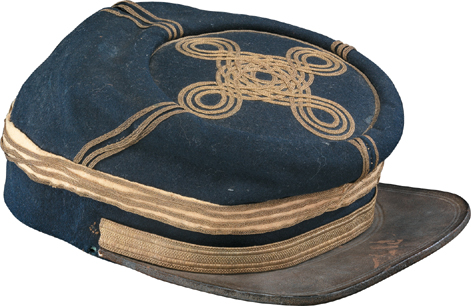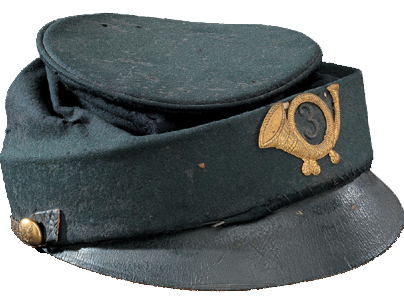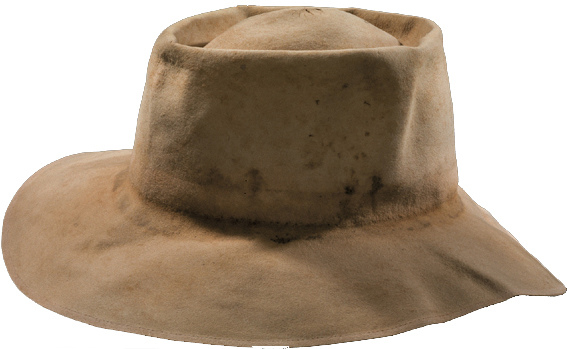 JLJ
JLJAS THE WAR PROGRESSED AND THE CLOTHING WORN by troops on either side became increasingly more uniform, Union and Confederate soldiers continued to wear an impressive assortment of hats and caps. That variety stemmed in part from the prewar precedent of equipping each soldier with two kinds of headgear. An order issued by the U.S. War Department in 1858 called for enlisted men to receive each year one dress hat such as the Hardee hat shown below, with a tall, stiff crown and a broad brim; and a fatigue or forage cap with a visor like those pictured on the following pages. During the Civil War, some soldiers proudly wore such dress hats, but others found them too awkward and uncomfortable and favored the kepi: a forage cap modeled loosely on the French képi. Union infantrymen, cavalrymen, and artillerymen wore kepis with different insignia, and many soldiers customized those caps by giving them distinctive shapes and wearing them with an attitude and flair exhibited with no other article of military clothing. The kepi defined the Civil War soldier, and the soldier placed his personal imprint on the kepi.
Rivaling the kepi in popularity, particularly among Confederates, was the slouch hat—a soft, broad-brimmed hat that could be molded to the wearer’s preference. Many soldiers on both sides purchased slouch hats, and some simulated them by reshaping their dress hats. The slouch hat’s broad brim offered more protection against the elements than did the kepi’s visor, although some men were issued waterproof covers for their caps.
Officers wore a variety of headgear, ranging from kepis and slouch hats that differed little from those worn by enlisted men to fancy chapeaux: narrow, elongated hats that protruded in front and in back and distinguished high-ranking navy and army officers from their subordinates on formal occasions. No men who fought in the Civil War donned more conspicuous headgear than Zouaves, who wore tasseled red fezzes not just for parades or reviews but when entering battle.  JLJ
JLJ
Hats with trimmings complete will be issued to enlisted men at the rate of one a year. For Fatigue purposes Forage Caps … will be issued … at the rate of one a year.
GENERAL ORDER NO. 13, WAR DEPARTMENT, NOVEMBER 30, 1858

UNION ARTILLERY DRESS HAT This Pattern 1858 Army Hat, also known as a Hardee hat, was authorized by the War Department three years before the Civil War began and was worn by some soldiers during the conflict, including the Union artilleryman pictured opposite. Made of stiff black felt, it replaced the Pattern 1851 Army Hat. This example and the hat worn by the soldier in the photograph are stamped with the crossed-cannons insignia of the artillery branch.
CONFEDERATE OFFICER’S BLUE KEPI This well-preserved blue cap with gold quatrefoil and lace was worn by Colonel Robert W. Harper of the 1st Arkansas Mounted Rifles, who also owned the slouch hat shown overleaf.

ZOUAVE FEZ Made of red wool with blue tassels, this characteristic Zouave fez is from the Smithsonian’s Schuylkill Arsenal collection.

CONFEDERATE OFFICER’S KEPI This gray wool Confederate forage cap is decorated with faded gold quatrefoil and three lines of lace, signifying that it was worn by a major or colonel.
MCCLELLAN CHASSEUR CAP Worn by General George McClellan, this well-tailored kepi, also known as a chasseur cap, was a taller type than most Civil War kepis and popular with soldiers of all ranks, who sometimes placed a wet sponge or handkerchief under the crown to keep cool.

MCCLELLAN CHAPEAU Adorned in gold with the U.S. coat of arms, this ceremonial chapeau was authorized for staff officers in 1858 and worn by General McClellan.

UNION INFANTRY “MCDOWELL” KEPI This Union officer’s forage cap, with the infantry’s bugle insignia, is of a type associated with General Irwin McDowell, who commanded Union troops at the First Battle of Bull Run.
GOSLINE ZOUAVE FORAGE CAP Men of the 95th Pennsylvania Volunteer Infantry, known as the “Gosline Zouaves,” wore this chasseur pattern cap of blue broadcloth with red piping, from the Schuylkill Arsenal collection.

CONFEDERATE SLOUCH HAT Like many soldiers on both sides, Colonel Robert Harper had both a kepi and a hat—in his case, the comfortable slouch hat shown here. Harper died in battle at Chickamauga on September 20, 1863, cut down by cannon fire.

BALTIMORE MOUNTED RIFLEMAN CAP Purchased from Canfield Bros. & Company in Baltimore, this forage cap was worn by militiaman Thomas Hill of the Maryland National Guard when he went to fight for the Union.
KEPI WITH WATERPROOF COVER Waterproof glazed-cotton covers for caps like the one shown at right over a Confederate kepi were purchased by both sides during the war. Not many were worn, however, and photographs of them in use are rare.

OFFICER’S CAMPAIGN HAT Also known as a “Burnside Pattern” hat, this softer version of the Hardee hat was much like a slouch hat in appearance and comfort. It was worn by Lieutenant Nathan Levy of the 10th Michigan Infantry.

UNION KEPI WITH CORPS BADGE Decorated with the diamond badge of the Third Corps, this was one of many Union caps displaying such corps insignia, introduced by the Army of the Potomac in 1863.